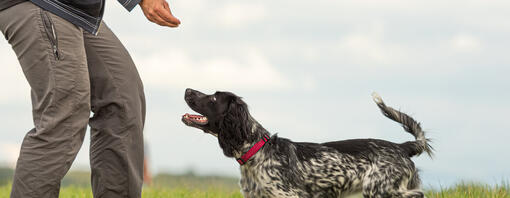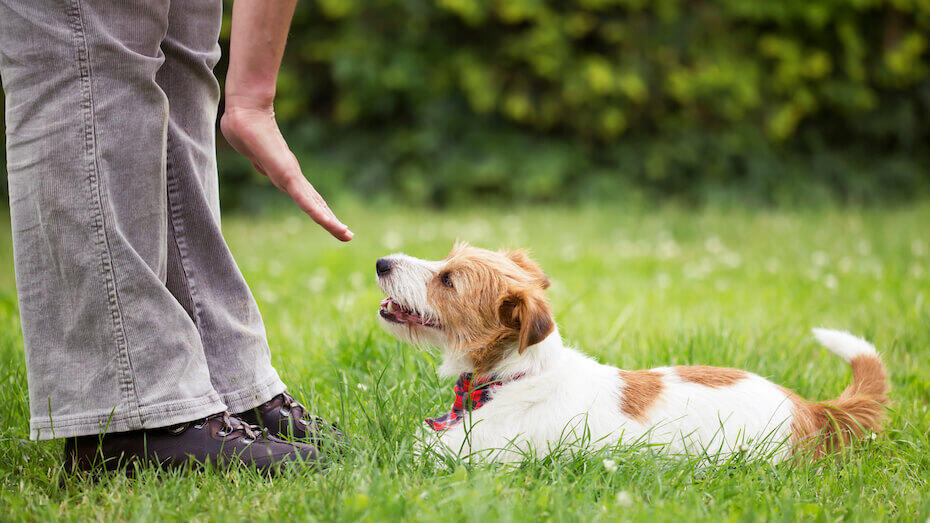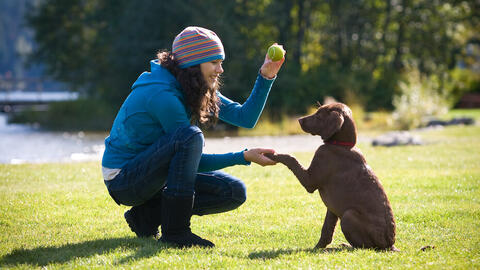
Understanding the importance of a well-behaved, obedient dog is an important step in making sure you have a good relationship with your furry friend – and we’re here to help you achieve this goal. This guide will delve into the various aspects of dog obedience training, offering insights to overcome any challenges you may encounter.
At Purina, we firmly believe that a well-trained dog paves the way for a happier, healthier relationship with your canine companion. Let's go ahead and see what obedience training means and how you can train your dog to be the best ‘boy’ or ‘girl’ they can be.
The Significance of Dog Obedience Training
Raising a puppy involves many essential aspects, with the most important one being the creation of a relationship based on trust between you and your dog. Achieving this trust requires dedication and time. But raising your puppy is not the same as training your dog as training is an important part of this education because it allows the animal to spend quality time with your and strengthen the bond your have together.
One of the primary reasons for dog obedience training is to manage behavioural issues. Dogs are inherently sociable creatures; however, without appropriate training, they may exhibit aggressive behaviour, excessive barking, or destructive habits. Consistent, steady training can rectify these issues, paving the way for a peaceful co-existence between you and your dog.
Training your dog offers benefits beyond just behaviour modification. It provides mental stimulation and physical exercise. The challenges posed by training sessions keep your dog engaged and prevent boredom; therefore, helping avoid destructive behaviours that often result from inadequate mental and physical stimulation.
Moreover, obedience training nurtures a stronger bond between you and your dog. It fosters trust, respect, and clear communication. When your dog understands and responds to your commands, it enhances your relationship. This bond is crucial for effective training and contributes to a content and well-adjusted pet.
Your Guide to Dog Obedience Training
Having a comprehensive guide is invaluable when it comes to obedience training for dogs. Whether you have a new puppy, or an older dog, obedience training is essential for their well-being and your peace of mind. This guide aims to walk you through the key elements of dog obedience training, helping you forge a strong bond with your canine friend. Here are a few steps you can take:
1. Choose the right method
The first step towards effective obedience dog training is selecting the right method. Each dog is unique, and their breed, age, and temperament must be considered when deciding on a training approach. Techniques that rely on positive reinforcement, such as rewards and praise, are usually effective and encourage your dog to learn and obey.
2. Teach the basic commands
Teaching your dog basic commands such as 'sit,' 'stay,' 'heel,' and 'come' is crucial for their safety and to maintain control over their behaviour. It’s always best to start with these simple commands as they provide structure and establish boundaries for your dog, making it easier for them to understand what is expected of them.
3. Pick the right environment
To conduct effective training sessions, setting up the right environment is critical. Choose a quiet, distraction-free area where you can focus with your dog. Using dog training treats or toys as rewards can motivate your dog during training. Break the training into short sessions to keep your dog engaged and prevent them from feeling overwhelmed.
You can then gradually increase distractions. Once the dog has learned a command in a quiet environment, we cannot expect them to obey us on the street with many new stimuli and distractions around. It is better to progressively increase the level of stimulation during training.
4. Be patient and consistent
Patience and consistency are very important when it comes to obedience training. Each dog learns at their own pace, so it's important to recognise their progress and provide positive reinforcement. With dedication, time, and the right training techniques, you can enjoy a well-behaved, obedient dog that brings joy to your life.
Overcoming Challenges in Dog Obedience Training
Challenges are bound to happen during dog obedience training. Understanding and addressing these issues can facilitate a successful training journey for you and your dog. So here are a few of which you should be aware:
Distractions
A common issue encountered during obedience training for dogs is distractions or lack of focus. Dogs can be easily distracted by other animals, sounds, or their own curiosity. This can make it difficult for them to stay attentive and follow commands. To tackle this, start training in a quiet, familiar environment, gradually introducing distractions as your dog progresses. Using positive reinforcement techniques, such as treats and praise, can also assist in maintaining your dog's focus and motivation.
During training, there will be times when your dog does not obey you. Just as they get frustrated when something doesn’t go right, you can also get frustrated. So try to think about why that might be and keep in mind that it’s a long journey that you must take together, with good and bad days.
Adjusting training methods
Another challenge is adjusting training techniques based on your dog's behaviour. Every dog is unique, and a method that works for one may not work for another. It's crucial to observe your dog's temperament, energy level, and learning style to tailor the training approach accordingly. Most dogs may respond better to reward-based methods, while others may require a more assertive approach. Patience and consistency are critical to finding the right techniques that resonate with your dog.
Contacting a professional trainer
In some instances, you may feel overwhelmed or unable to make progress despite your best efforts. This is when seeking professional assistance can be invaluable. Professional dog trainers have extensive knowledge and experience in tackling various training challenges. They can offer personalised guidance, identify underlying issues, and provide effective solutions. If you're feeling stuck or overwhelmed, don't hesitate to contact a professional trainer who can assist both you and your dog.
It's also important to find a trainer who uses techniques that respect the animal’s well-being, without using choke collars, electric collars, shouting, or hitting. These methods are never justified, and you will surely be able to find another professional with more training who can help you and your dog.
We hope you found this guide helpful. If you’re interested in more guides on training, check out Puppy Training Advice and Tips for more useful information on how to build a strong relationship with your pup through training.




